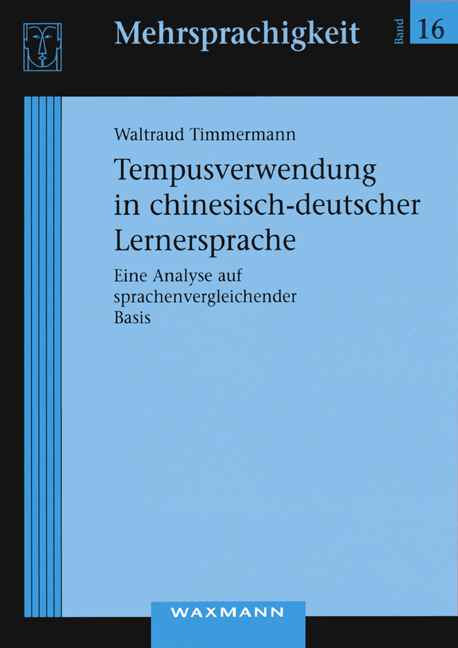Waltraud Timmermann
Tempusverwendung in chinesisch-deutscher Lernersprache
Eine Analyse auf sprachenvergleichender Basis
2005, Mehrsprachigkeit / Multilingualism, Band 16, 304 pages, E-Book (PDF), 26,90 €, ISBN 978-3-8309-6485-8
Die Untersuchung kontrastiert zunächst die Funktion der deutschen Tempora mit der aspektuellen Verbmorphologie des Chinesischen und zeichnet die daraus erwachsenden Konsequenzen für den Aufbau temporaler Strukturen anhand deutscher und chinesischer biografischer Diskursbeispiele nach. Vor diesem Hintergrund wird danach in den Lernersprachenanalysen gezeigt, wie Konzepte der Muttersprache in die lernersprachliche Tempusverwendung übertragen werden.
Aus den Analyseergebnissen leitet die Verfasserin abschließend didaktische Konsequenzen für die Behandlung des Tempus im Unterricht allgemein und für chinesische Lerner im Besonderen ab. Die Untersuchung wird durch einen Anhang mit verschriftlichten Lerner-Interviews ergänzt.
Summary
The use of tenses is a highly complex problem in foreign language acquisition. This is especially true for students whose native language does not have tenses, for example Chinese. The following analysis of oral Chinese-German interlanguage will show that even advanced learners do not consequently apply past and perfect tense morphology where necessary. The database consists of transcribed series of interviews with Chinese Germanistic students.
The investigation, oriented on the theoretical framework of Functional Pragmatics, focuses on the problem of transfer: Does the deviating distribution of tense application reflect temporal concepts of the learners’ native language that knows only aspect?
The application of tenses will be discussed in the context of biographical discourses: chronological account, “Schilderung” (a non-chronological, theme oriented type of account) and biographical narrative. This method of proceeding stems from the recognition that tense morphemes, as well as aspect morphemes, develop their communicative functionality only in the context of discourse and are dependant on discourse type; they can not be adequately analysed when analysed as isolated phenomena.
The chosen research question requires the prior investigation of tense choice in discourse between native speakers. The analysis is based on the assumption that temporal information is comprised of three components, namely actionality (as a phase concept of events), viewpoint aspect and time reference. Tenses contribute to the latter in a deictic (speaker oriented) way, but not in the sense of objective time reference. It is the opposition and overlap of speaker oriented and objective time reference that will be the crucial question in the analysis of native German discourse examples.
Additionally the three above-distinguished temporal components allow the comparison of languages: The function of Chinese verb morphology can be identified as viewpoint aspect. The lack of tense requires compensatory linguistic means and strategies, in order to communicate full temporal information. How this is achieved will be shown in the analysis of Chinese examples of the above mentioned biographical discourse types.
In the next step, the results of the comparative analysis will be used in the transfer analysis to plausibly show how transfer takes place in language learners.
The prominent transfer phenomena are:
· Adequate application of past time morphemes correlates positively with contexts that are conceptualised or even marked as perfective in Chinese. This observation is in accordance with the existing literature.
· Moreover, in states, which in Chinese are conceptualised as continuous and are therefore incompatible with perfective aspect, the rate of adequate past tense marking decreases. That means, present tense application correlates with contexts that are conceptualised as modal, habitual or descriptive.
These observations indicate that students base their learner hypothesis about tense / temporal deixis on the Chinese viewpoint concept. It is remarkable however that the two students, whose interlanguages are analysed in two case studies in detail, do it in different forms and with different resulting patterns of morpheme application.
The interlanguage analysis leads to two didactic proposals:
· The nature of the temporal deixis in contrast to the aspectual concept can best be clarified in the case of combining past and perfective, that means the pluperfect.
· Tenses should not be taught as isolated forms and by abstract application rules, but instead incorporated into various and relevant discourse types.
press
ansprechende analytische Leistung [...] mit ihrer Arbeit [leistet die Vfn.] einen äußerst wichtigen Beitrag für den Bereich Deutsch als Fremdsprache, vor allem durch die Analyse von Abweichungen in der Fremdsprache unter Einbeziehung muttersprachlicher Aspekte bei Lernenden und durch kontrastive Sprachbetrachtungen.
Angelika Gärtner in: Deutsch als Fremdsprache. H.2. 2007.
Die Studie liefert nicht nur einen guten Einblick in die Tempusverwendung chinesischer Deutschlernender, sondern eruiert auch Ursachen für vorhandene Defizite und thematisiert didaktische Konsequenzen für die Behandlung des deutschen Tempussystems im DaF-Unterricht.
Susanne Günther in: Germanistik. Band 47, Heft 3-4. S. 576.

